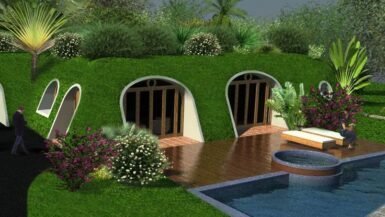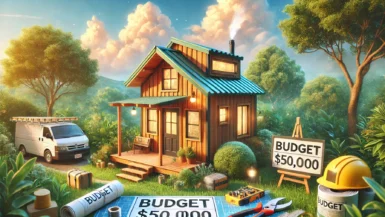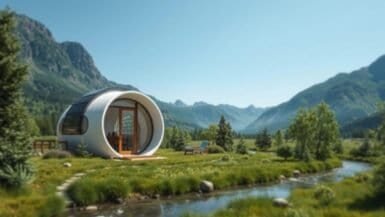As sustainable living continues to gain momentum, tiny homes have become the epitome of eco-friendly dwellings. One innovative aspect of these small abodes is the integration of green roofs, which provide numerous environmental, aesthetic, and energy-saving benefits. In this article, we delve into the top 5 green roof options for tiny homes, exploring the features and advantages of each, as well as the considerations to keep in mind while selecting the most suitable option for your sustainable tiny house. Discover how to transform your tiny home’s roof into a flourishing oasis, while significantly reducing your ecological footprint and enhancing your living space.
Eco-Friendly Sedum Blankets: A Lightweight Green Roof Solution
As tiny homes often have limited structural capabilities, it’s essential to choose a green roof option that’s not only sustainable but also lightweight. Sedum blankets, also known as sedum mats, are an excellent solution, offering a low-maintenance, visually-appealing, and environmentally-friendly option for your tiny home’s roof. In this section, we will discuss the benefits of sedum blankets, installation and maintenance tips, and how they compare to other green roof options.
Benefits of Sedum Blankets in Tiny Homes
Sedum blankets provide numerous advantages for tiny home dwellers. These include:
1. Lightweight: Sedum blankets are highly suitable for tiny homes due to their lightweight nature. They are typically composed of a thin layer of growing medium and pre-grown sedum plants, resulting in a lighter load on your tiny home’s roof structure.
2. Aesthetic Appeal: With their lush, colorful foliage, sedum blankets can significantly enhance your tiny home’s appearance. They also change colors throughout the seasons, creating a dynamic and visually-pleasing display.
3. Low-Maintenance: Sedum plants are hardy, drought-tolerant, and require minimal care, making them an ideal choice for busy homeowners or those with limited gardening experience.
4. Improved Insulation: In addition to their aesthetic benefits, sedum blankets also provide enhanced insulation, which can help regulate indoor temperatures and reduce the need for air conditioning or heating.
5. Environmental Benefits: Green roofs, including sedum blankets, contribute to cleaner air, reduced stormwater runoff, and increased urban biodiversity.
Installation and Maintenance Tips
Sedum blankets can be installed on a variety of roof types, including flat, sloped, and curved surfaces. It’s crucial to ensure that your tiny home’s roof structure is strong enough to support the additional weight of the sedum blanket, especially when saturated with water.
When it comes to maintenance, sedum blankets are relatively low-maintenance. Regular tasks include watering during prolonged dry periods, removing dead plants and debris, and adding a slow-release fertilizer once or twice a year. Additionally, periodic inspection of the roof membrane and drainage system is necessary to ensure the proper functioning of the green roof.
Comparing Sedum Blankets to Other Green Roof Options
While sedum blankets are an excellent lightweight green roof solution, it’s essential to consider other options and weigh their pros and cons. Some alternative green roof options include modular green roof systems, native plant gardens, and solar green roofs.
Sedum blankets are ideal for homeowners who prioritize a lightweight, low-maintenance, and visually-appealing solution. However, if you’re looking for more flexibility in plant selection or want to incorporate renewable energy sources, other green roof options may be more suitable. Ultimately, the best choice for your tiny home will depend on your specific needs, preferences, and budget.
Native Plant Gardens: Supporting Local Biodiversity on Tiny Home Roofs
Creating a native plant garden on your tiny home’s roof not only adds a unique touch of natural beauty, but also contributes to the local ecosystem by supporting native flora and fauna. In this section, we will explore the advantages of native plant gardens, the process of selecting suitable plants, and tips for installing and maintaining a thriving rooftop habitat that benefits both you and the environment.
Benefits of Native Plant Gardens for Tiny Homes
Incorporating native plants into your tiny home’s green roof offers various advantages, such as:
1. Supporting Local Ecosystems: Native plants are well-adapted to local conditions and provide essential habitat and food sources for native wildlife, including pollinators like bees and butterflies.
2. Low-Maintenance: As native plants are accustomed to the local climate and soil conditions, they typically require less maintenance, including watering and fertilizing, compared to non-native species.
3. Drought and Pest Resistance: Native plants have evolved to withstand local pests and weather conditions, which often makes them more resistant to these challenges than non-native species.
4. Unique Aesthetic: A rooftop garden filled with native plants can create a distinct and eye-catching display that showcases the beauty of your region’s flora.
Selecting and Planting Native Species
To create a successful native plant garden on your tiny home’s roof, it’s crucial to carefully select suitable plants that can thrive in rooftop conditions. Consider factors such as the sun exposure, wind, and weight limitations of your roof, as well as the plants’ growth habits and requirements.
Consult local nurseries, native plant societies, or online resources to identify the best native plants for your specific location and rooftop conditions. It’s essential to choose a variety of plants that can provide year-round interest and support for local wildlife, such as flowering species for pollinators, and plants with berries or seeds for birds.
Once you’ve selected your plants, carefully plan their placement, considering factors such as height, spread, and root depth. Be sure to use a suitable lightweight growing medium tailored to your native plants’ needs, and install proper drainage and irrigation systems.
Maintaining Your Native Plant Garden
While native plant gardens typically require less maintenance than non-native options, it’s still essential to ensure your rooftop ecosystem remains healthy and vibrant. Regular tasks include watering during dry periods, pruning to maintain the desired shape and size, and removing any invasive non-native species that may appear.
Perform periodic checks on the health of your plants, the condition of the growing medium, and the functionality of the drainage and irrigation systems. By staying proactive with maintenance, you can enjoy a flourishing native plant garden that enhances your tiny home and supports the local ecosystem for years to come.
In summary, native plant gardens are a fantastic option for tiny home green roofs, offering a unique aesthetic and supporting local biodiversity. By carefully selecting suitable native species and ensuring proper installation and maintenance, you can create a thriving rooftop habitat that benefits both you and the environment.
Modular Green Roof Systems: Customizable and Low-Maintenance Options
Modular green roof systems have emerged as a popular choice for tiny home dwellers seeking a customizable, low-maintenance, and attractive green roof solution. These systems consist of pre-planted modules or trays that can be easily arranged and reconfigured, allowing homeowners to adapt their green roof to suit their preferences and needs. In this section, we will explore the advantages of modular green roof systems, design possibilities, and tips for installation and upkeep to help you make an informed decision for your tiny home’s green roof.
Advantages of Modular Green Roof Systems
Choosing a modular green roof system for your tiny home presents several benefits, including:
1. Customizability: Modular systems offer a high degree of flexibility, as the individual modules can be rearranged, removed, or replaced to suit your taste or changing requirements.
2. Easy Installation: The pre-planted modules make installation a breeze, often requiring minimal effort and time compared to traditional green roof installations.
3. Low-Maintenance: Many modular systems come with built-in drainage and irrigation components, simplifying maintenance and ensuring your green roof remains healthy and vibrant.
4. Lightweight Options: Some modular systems are specifically designed with lightweight materials to accommodate the structural limitations of tiny homes.
5. Enhanced Aesthetic Appeal: The ability to mix and match different plant varieties and module designs can lead to a visually striking and unique green roof.
Design Possibilities with Modular Green Roof Systems
One of the most appealing aspects of modular green roof systems is the vast range of design possibilities. Homeowners can choose from an array of plant types, colors, and textures, creating a green roof that reflects their personal style and vision. Additionally, modular systems can often be adapted to incorporate features such as seating areas, walkways, or even rooftop vegetable gardens, further enhancing the functionality and appeal of your tiny home’s green roof.
Installation and Maintenance Tips
Installing a modular green roof system typically involves placing the pre-planted modules onto a waterproof membrane and connecting them according to the desired layout. It’s crucial to ensure your tiny home’s roof structure can support the weight of the modular system, particularly when saturated with water.
In terms of maintenance, modular green roof systems generally require less effort than traditional green roofs, as the built-in drainage and irrigation components simplify upkeep. However, it’s still essential to regularly check the health of your plants, remove any dead or damaged foliage, and monitor the functionality of the drainage and irrigation systems. Occasionally, the modules may need to be rearranged to optimize sunlight exposure or prevent overcrowding.
By selecting a modular green roof system for your tiny home, you can enjoy a customizable, low-maintenance, and visually appealing green roof solution that suits your unique needs and preferences. With proper installation and care, your modular green roof can provide years of enjoyment and environmental benefits for you and your tiny home.
Solar Green Roofs: Combining Renewable Energy and Plant Life
Embracing the best of both worlds, solar green roofs integrate photovoltaic (PV) panels with living plants, creating a multifunctional space that generates clean energy while promoting biodiversity. This innovative approach allows tiny home owners to maximize their limited roof space and enjoy the benefits of both green roofs and solar energy. In this section, we will delve into the advantages of solar green roofs, explore design considerations, and provide tips for successfully implementing this eco-friendly solution on your tiny home.
Advantages of Solar Green Roofs for Tiny Homes
The integration of solar panels and green roof elements offers numerous benefits for tiny home dwellers, including:
1. Renewable Energy Generation: Solar panels can harness the sun’s energy to produce electricity for your tiny home, reducing your reliance on non-renewable energy sources and lowering utility bills.
2. Enhanced Green Roof Performance: The shade provided by solar panels can create a more comfortable microclimate for plants, as well as reduce water evaporation, resulting in a healthier and more robust green roof.
3. Improved Solar Panel Efficiency: Green roofs have been shown to lower roof surface temperatures, which can help enhance the efficiency of solar panels, as they typically perform better in cooler conditions.
4. Space Optimization: By combining solar panels and green roof elements, tiny home owners can make the most of their limited roof space and enjoy the benefits of both technologies.
5. Environmental Benefits: Solar green roofs contribute to cleaner air, reduced stormwater runoff, and increased urban biodiversity, while also generating clean, renewable energy.
Design Considerations for Solar Green Roofs
Successfully integrating solar panels and green roof elements requires careful planning and design. Consider the following factors when designing your solar green roof:
1. Roof Load Capacity: Ensure your tiny home’s roof structure can support the combined weight of the solar panels, green roof components, and any additional loads.
2. Orientation and Tilt: Optimize the placement and angle of the solar panels to maximize sun exposure and energy generation.
3. Plant Selection: Choose plants that can thrive in the microclimate created by the solar panels, taking into account factors such as shade, wind, and moisture levels.
4. Drainage and Irrigation: Proper drainage and irrigation systems are crucial for maintaining a healthy green roof and protecting the solar panels from potential water damage.
5. Maintenance Access: Ensure that both the solar panels and green roof components are easily accessible for regular maintenance and cleaning.
Implementing a Solar Green Roof on Your Tiny Home
Once you have carefully considered the design aspects of your solar green roof, it’s time to bring your vision to life. Consult with professionals experienced in both solar panel installation and green roof systems to ensure a seamless integration of the two technologies. Regular maintenance of your solar green roof, including cleaning the solar panels, monitoring the health of the plants, and inspecting the drainage and irrigation systems, will ensure the longevity and optimal performance of your eco-friendly rooftop oasis.
By incorporating a solar green roof on your tiny home, you can enjoy the benefits of both renewable energy generation and a flourishing green space. This innovative solution allows you to make the most of your limited roof area while significantly reducing your ecological footprint and enhancing your living environment.
Recycled Material Green Roofs: Sustainable and Affordable Choices
Utilizing recycled materials for your tiny home’s green roof is an innovative and eco-friendly way to minimize waste, reduce costs, and create a unique, sustainable living space. In this section, we will explore the various types of recycled materials that can be used in green roof construction, the benefits of opting for this approach, and tips for sourcing and incorporating these materials into your green roof design.
Types of Recycled Materials for Green Roof Construction
There is a wide variety of recycled materials that can be repurposed for green roof construction, ranging from growing media to structural components. Some popular options include:
1. Recycled Rubber: Old tires can be shredded and used as a drainage layer, providing a lightweight and affordable alternative to traditional drainage materials.
2. Recycled Plastic: Plastic containers, such as milk jugs or soda bottles, can be repurposed as planters or used to create modular green roof systems.
3. Recycled Glass: Crushed glass can be mixed with soil to create a lightweight and well-draining growing medium for plants.
4. Recycled Bricks and Concrete: Broken bricks or concrete can be used as a base layer for green roofs, providing stability and improved drainage.
5. Recycled Organic Matter: Composted yard waste, food scraps, and other organic materials can be used as a nutrient-rich growing medium for your green roof plants.
Benefits of Using Recycled Materials in Green Roofs
Incorporating recycled materials into your tiny home’s green roof offers several advantages, such as:
1. Environmental Impact: By repurposing waste materials, you can help reduce the amount of waste sent to landfills and decrease the demand for new resources.
2. Cost Savings: Using recycled materials can often be more affordable than purchasing new materials, helping to reduce the overall cost of your green roof project.
3. Unique Aesthetic: Recycled materials can create a distinctive and visually interesting green roof, showcasing your commitment to sustainability and innovation.
4. Improved Drainage and Insulation: Some recycled materials, such as crushed glass or rubber, can enhance the drainage and insulation properties of your green roof, contributing to better plant health and energy efficiency.
Sourcing and Incorporating Recycled Materials into Your Green Roof Design
When planning your green roof project, consider the types of recycled materials that are readily available in your area and suitable for your specific needs. Local recycling centers, construction sites, and community composting programs can be excellent sources for obtaining the materials you require.
Before using any recycled material, it’s crucial to ensure it’s free of contaminants and safe for use in green roof construction. Consult with green roof professionals or conduct thorough research to determine the best practices for preparing and incorporating each material into your design.
Keep in mind that using recycled materials may require additional planning and creativity, as you’ll need to adapt your green roof design to accommodate the unique characteristics of each material. However, the environmental and financial benefits, along with the opportunity to create a one-of-a-kind rooftop oasis, make recycled material green roofs a compelling choice for tiny home dwellers.
By embracing recycled materials for your tiny home’s green roof, you can create a sustainable, affordable, and visually captivating space that showcases your commitment to environmental stewardship. With careful planning and resourcefulness, your recycled material green roof will serve as a testament to the power of innovative and eco-friendly design.





Leave a reply